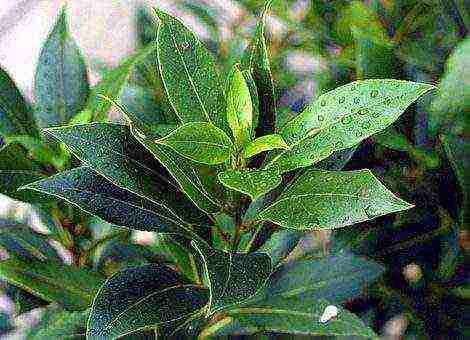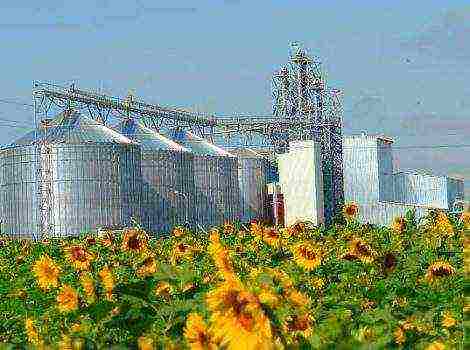Content
- 1 Biological features
- 2 Basic requirements for growing peanuts on the site
- 3 Stage one. Preparing the site
- 4 Stage two. Choosing and preparing planting material
- 5 Stage two. Landing
- 6 Stage three. Further care
- 7 Stage four. Harvesting
- 8 About other ways to grow peanuts
- 9 Choosing the right seeds
- 10 Choosing the right time
- 11 Germinating seeds before planting
- 12 Planting seeds in a pot or soil
- 13 Hilling and watering
- 14 Harvesting
- 15 Storing peanuts
- 16 Choosing seeds
- 17 Choosing a site
- 18 Cooking the ground
- 19 Preparing peanuts for planting
- 20 Planting peanuts in the garden
- 21 Peanut care
- 22 Harvesting peanuts in the garden
- 23 Some helpful tips
- 24 Video: how to plant peanuts (groundnuts)
The peanut, which is so loved by many, can be grown in the garden. Growing peanuts is not as difficult as it might seem. It is only necessary to select and sow an early-ripening variety, and also strictly follow all agrotechnical recommendations.
Peanut
Biological features
Despite the fact that peanuts are considered a nut, in reality they are a distant relative of beans. This is an annual legume crop with a height of about 0.5-0.6 m, having a taproot, which, in turn, deepens by 1.5 m.The diameter of the upper part of the rhizome can reach 1 m, which, in fact, explains the resistance of peanuts to droughts.
Peanuts on the field
The leaves are paired, have a dark green tint. Flowers are collected in inflorescences in the leaf axils and are orange or yellow. One flower develops in the inflorescence, due to which the flowering phase lasts from the last days of June until the onset of autumn cold weather. Flowers open at about 7 am and bloom until noon.
Peanut bush
Note! Each bush produces an average of 30-70 beans and about 2,000 flowers.
A few days after flowering, a young ovary begins to develop in the place of each flower, which is a kind of aerial "root", bending and heading towards the ground. In the language of science, these ovaries are called gynophores and are designed to protect offspring from drought and heat. The upper part of the gynophore, after penetrating into the ground, grows rapidly and forms a pod in the shape of a cocoon or cylinder (for this reason, soil looseness is so important when growing a crop). Each such bean produces 1 to 4 oval-shaped pink seeds.
Peanut fruit
Basic requirements for growing peanuts on the site
Consider what conditions should be provided for the normal development of culture.
- If peanuts are grown in large quantities in order to obtain oil, then it should be borne in mind that the color depends directly on the soil. The oil obtained from beans planted in light soil will be light, and in dark - accordingly, dark.
- Nuts form in the ground, so it must be loose. As for the specific type, black soil, neutral or sandy loam soil is most suitable for peanuts.
The soil must be loose
- The culture grows well in the beds where tomatoes, cucumbers, potatoes and cereals were previously grown. It is undesirable to plant peanuts after other legumes (peas, beans, etc.).
- The most suitable temperature for peanuts is considered to be 20-27 ° C.If this indicator falls below 15 ° C or exceeds 30 ° C, then the plants will simply stop growing.
- During the period of flowering and formation of underground beans, plants need constant moisture, but water stagnation should not be allowed. And around September, during the period of seed ripening, excess moisture can slow down this process.
Avoid stagnant water
- The beds where peanuts are planted should be ventilated.
- Finally, the bushes should be well lit. It is unacceptable to have plants near peanuts that can shade it.
Peanuts grow well in sunny places
If at least one of the above conditions is violated, then the culture will begin to hurt - spots form on its leaves, indicating the development of root rot.
Stage one. Preparing the site
Start preparing the beds in the fall. Dig the selected area to the depth of a bayonet shovel, then apply organic fertilizer - compost, humus or wood ash at the rate of 2-3 kg / m². In the spring, cultivate the area (to a depth of no more than 10 cm) and remove the weeds along with the roots. It is also advisable to add nitrophosphate (about 50 g / m²).
Cultivation
Stage two. Choosing and preparing planting material
To get the greatest yield, give preference to zoned varieties. Buy them from a reliable gardening store or alternatively from friends or neighbors. As seeds, not only beans (crushed / whole) can be used, but also husked seeds.
Planting material
The most common varieties of peanuts in temperate climates include the following:
- Stepnyak;
- Klinskaya;
- Krasnodarets 14;
- Valencia 433.
Note! When buying, be extremely careful so that you do not slip fried or otherwise processed grains. Otherwise, time and money will be wasted.
Preparation of planting material for peanuts
Groundnuts can be grown both by sowing in open soil and through seedlings. If you prefer the first option, then use only those seeds that were collected no more than 2 years ago (germination is lost over the years). Regardless of the chosen method, the grain must be germinated around the last days of April. To do this, follow the instructions below.
Step one. Take the seeds and immerse them in a weak solution of potassium permanganate for 15 minutes to disinfect.
Potassium permanganate solution
Step two. Rinse the seeds with running water and soak for germination. After 10 days, the first shoots are formed.
Soak
Step three... Temper the resulting sprouts. To do this, during the day, keep them in a room with a temperature of the order of 3 ° C for several days, but transfer them overnight to where the temperature is at room temperature.
Sprouts
Stage two. Landing
Further, the germinated seeds are sown in the soil or grown for seedlings. Let's get acquainted with the features of each of the methods.
Method one. Planting in open soil
When the temperature regime is at least 20 ° C (for the forest-steppe, this is usually mid-May), and the ground at a 10-centimeter depth warms up to at least 15 ° C, you can start sowing germinated seeds. If the temperature is lower, then the seeds will simply rot before they can sprout.
Prepare the planting site using one of two possible schemes:
- square-nested (0.7x0.7 m or 0.6x0.6 m), in which 5-6 grains must be placed in the hole;
- wide-row (the distance between the bushes is 15-20 cm, the row spacing is somewhere around 60 cm).
Groundnut peanuts: cultivation
In both the first and second methods, the sowing depth should be 6-8 cm. Take only large grains, since small or damaged seedlings may not give rise. After sowing, cover the holes with earth, compact slightly.It is worth noting that the shell of nuts contains many beneficial microorganisms, so many gardeners grind it and place it in the holes during planting.
Note! At first, protect the planting from birds (such as magpies, crows, etc.), because they can destroy not only young shoots, but also seed.
How to protect peanuts
To protect yourself from the bear, you can make one simple bait: collect the grain and cleanings, dig it all in on the garden bed, and then cover it with a piece of roofing material. Pour manure or plant debris on top. Make several of these lures and look at them from time to time, collecting a bear.
Growing peanuts in the field
Video - Planting peanuts
Method two. Growing seedlings
As noted earlier, peanuts can also be grown using seedlings. In this case, proceed according to the following algorithm.
Planting peanuts in a cup
Table. How to grow peanuts seedlings
Conditions for growing good seedlings of peanuts
Stage three. Further care
In May, the land is still sufficiently moistened with melt water, which means that it should be watered only after the mass emergence of shoots (twice a month, using only water heated in the sun). Better to resort to drip irrigation or, alternatively, furrow irrigation. Young shoots will immediately turn yellow.
An equally important condition for a good harvest is periodic hilling.
Hilling peanuts
Perform this procedure several times per season.
- Before flowering, spud the plants to a height of 0.5-0.7 m.
- The second time hilling is done 10 days after the beginning of flowering.
- In the future, do this every 10 days, over time, reducing the distance between the gynophores that appeared during flowering and the soil. Make the final hilling in early August.
Using the technique for hilling
Video - Hilling peanuts
Finally, add min. fertilizers, namely 450 g of potassium (if we are talking about sandy loam soil), 500-600 g of phosphorus and 450-600 g of nitrogen for each hundred square meters of land.
Apply top dressing:
- during the formation of true leaves;
- while tying buds;
- during fruit setting.
Stage four. Harvesting
Peanut harvesting process
By mid-autumn, the fruits should ripen. Roughly in early October, when the weather is dry, dig out the bushes with a shovel. Lightly shake each bush off the ground, turn it over and lay it on the ground with the root system up so that the fruits dry out a little. Then move them indoors or under a shed to dry and keep them there for at least 4 days.
Snapshot of ripe peanuts
Once the stems have dried naturally, start to process the peanuts. Next, dry the fruits at room temperature and place them in cardboard boxes for storage (you can use small canvas bags instead of the latter). Store fruits in a dry and well-ventilated place.
Note! To speed up the drying process, you can use, for example, an oven, but the temperature in the appliance should not exceed 40 ° C.
About other ways to grow peanuts
There are other, less popular growing methods, which in fairness should also be familiar (at least in general terms).
In warm beds
How to make warm beds
Warm beds
When choosing one or another method, you should pay attention to warm beds. Prepare the latter in autumn or early spring, following the instructions below.
Step one... Decide on a place and dig trenches of 15-20 cm. The recommended width of the beds is 1 m, as for the length, it can be any.
Step two... Place the top layer of soil on one side of the trench and the bottom layer on the other.
Step three... Cover the bottom with plant remains, sprinkle them with a small amount of soil. Sprinkle rotten compost on top.
Step four. Cover the beds with a top layer of earth.
After about 60 days, the beds will consist of warm, nutritious soil, which is ideal for growing crops.
Heating the beds with a cable
Houses
After growing the seedlings, you can leave yourself 2-3 sprouts to grow on the windowsill.
Step one. Take a wide container and fill it with earth mixed with sand / humus.
Step two. Plant the plants in the soil, place the container on the lightest windowsill (there should be no drafts in the room).
Peanut sprouts
Step three. Expect a flower to emerge and a pod to form. Make sure that the shoots do not go beyond the container, otherwise the set fruit will not develop.
Step four. Loosen and water the soil periodically.
Step five... When the plant stops growing and the leaves turn yellow, you can harvest the fruit.
Peanuts on the windowsill
In the greenhouse
In greenhouse conditions, the culture feels quite comfortable, especially next to tomatoes (the latter should not be located too densely so as not to shade the peanuts). In this case, the peanuts will share nitrogen with the tomatoes, and you only need to huddle the bushes twice (in June).
In general, planting and care is not much different from what needs to be done when growing in open soil, except that the vents and ends of the greenhouse need to be periodically opened for ventilation. Harvesting can start as early as September.
Video - Features of growing peanuts
 Peanuts are very healthy and nutritious ... no, not a nut. In fact, botanists classify peanuts as a legume. We, by mistake and habit, call peanuts a nut. But whatever we call it, peanuts are delicious and very healthy.
Peanuts are very healthy and nutritious ... no, not a nut. In fact, botanists classify peanuts as a legume. We, by mistake and habit, call peanuts a nut. But whatever we call it, peanuts are delicious and very healthy.
It is saturated with macro- and microelements necessary for the human body, and therefore is in demand among those who like to eat tasty, satisfying and beneficial for the body.
In this regard, many adherents of a healthy lifestyle and proper nutrition are wondering how to grow peanuts at home.
To the delight of everyone who seeks to grow peanuts on their own, it must be said that this is very easy to do and does not require any special knowledge or super-efforts.
There is practically no difference between how to grow peanuts at home or in the garden, it is important to know only some general nuances:
Choosing the right seeds
Peanuts, like all types of plants, are different. The most important difference is the size of the beans: large-seeded and small-seeded. Specialty stores usually sell seeds of your choice, so read the instructions before buying.
The most common ones are:
- Virginia is the classic most common peanut.
- Valencia seeds will give you large and delicious kernels.
- On the other hand, the Spanish variety grows into small peanuts, which, as a rule, are used on an industrial scale for the production of peanut products: pasta, kozinak and for confectionery.
Thus, it is more correct to buy seeds from a vegetable gardening store. But some are trying their luck trying to grow the plant from seeds purchased from the grocery store. This is a matter of luck: it is quite possible that you will be lucky and such peanuts will delight you with their sprouts, and subsequently with a bountiful harvest.
The most important thing to pay attention to is the integrity of the bean shell, it must be without any mechanical damage, it must be dry in moderation, that is, not overdried. And, of course, in no case should peanuts be fried!
What else can you grow at home:
How to grow parsley
How to grow lemon
How to grow pepper
How to grow strawberries at home
Choosing the right time
If you live in the southern latitudes, then it is best to plant the plant in the last days of April. If in the north, then a little earlier, right after all the frosts.The most important thing to consider: the homeland of this plant is South America, therefore it is very thermophilic, does not tolerate low temperatures, their drops, drafts and excessive humidity.
Germinating seeds before planting
Before growing peanuts in a garden or at home in a pot, it must be germinated. To do this, we soak the seeds in water, you can use a weak solution of potassium permanganate or epin. Then we put it in a damp cloth, you can use cheesecloth and leave it overnight. Usually, the next morning, small seedlings are shown. Can be planted right away or left to stand for another day, but the fabric should be damp.
Planting seeds in a pot or soil
The main rule when planting: it is very important not to damage the top layer - the brown film, otherwise the peanuts may not sprout.
The soil should be loose and well-drained. The seeds sprout, which literally after 2 weeks begin to bloom, a day or two and the flower falls off, shoots form instead. Under their weight, the stem tilts to the ground and goes into the depths. Subsequently, your first crop is formed from these shoots.
After seed germination, three further options are possible.
The first option: we plant seeds in a pot for growing at home
We fill it 2/3 with loose earth and press the peanut seeds at approximately the same distance from each other.
From above we fall asleep another 3 centimeters.
The main condition for how to grow peanuts at home: a wide pot and providing greenhouse conditions to the first leaves.
After planting, the pot can be covered with a special lid or stretched with plastic. The plant loves the sun, so we choose the brightest place in the house protected from drafts.
The second option: we plant it in a pot for further planting in the ground
In the case when you plan to plant peanuts in the garden, the principle of planting in a pot is the same.
For convenience, so as not to damage the root system during transplantation, you can use a peat pot, which is then buried in the ground along with the sprouted peanuts.
An important rule of how to grow peanuts in the country, which must not be forgotten: the plant is very thermophilic, therefore it is worth planting in an open area after all the frosts have passed, the earth has warmed up, and the air temperature is stable at about 18 degrees.
You can improve the conditions for peanuts by adding sand to the soil and mixing. It is necessary to plant at the rate: each seed at a distance of about 20 cm from each other.
The third option: we plant directly into the ground
It is quite possible to plant seeds sprouted in moist matter immediately in the garden. If it is still cool outside or there are temperature drops, then it is best to equip a greenhouse.
As a general rule, after planting, the plant must be watered so that the ground is moist, but without the formation of puddles on the surface.
Hilling and watering
Seedlings will not keep you waiting. About 10 days and you will see the first leaves above the ground. We begin to huddle so that the entire root system and stem are underground, and only foliage is visible on the surface. Complex vitamin fertilizers can be applied to the ground. Watering at the very beginning is necessary to a state so that the earth is moist, after ripening - watering quite a bit so that the ripe crop does not rot.
Harvesting
The average ripening period for beans is 120-130 days. Usually, before the first frost, when the plant stops growing, you can start harvesting. In order not to damage the pods with peanut kernels, the bush is pulled out entirely, carefully prying the root system with a shovel.
Storing peanuts
The question of how to properly store peanuts at home is very important. Because, if stored improperly, peanuts are prone to spoilage and mold. After collecting the bushes, it is best to dry them in their original form: simply by tying the plants in one sheaf and hanging them by the stems with the roots down.
The room must be dry, warm and ventilated. This is the best way to store it.Drying peanut pods usually takes about 3-4 weeks, during which time they ripen. The pods can then be rinsed with water. Then, to avoid mold and mildew, they can be dried on a baking sheet by placing it on a heat source. Can be dried on an electric stove.
You need to dry it until the shell flap becomes dry, hard and easily breaks when pressed. It is worth remembering the main thing about how to store peanuts for planting: it must be dry, the room must be periodically ventilated, and the largest beans of the crop must be selected for planting. The most ideal option is storage in canvas bags. With this storage, the seeds will survive until the next sowing season and will again delight you with an abundant tasty harvest.
There is nothing difficult in growing peanuts. But how much joy and benefit from your own harvest.
After all, peanuts contain so many useful vitamins (B1, B2, B3, B4, B5, B6, B9, C, PP, A, D), minerals (potassium, magnesium, calcium, phosphorus, sodium, iron, zinc), unique amino acids a also biotin, folic and lyonolic acids, vegetable fats and other useful elements.
And although peanuts are 50% fat, everything is so harmonious and balanced that it is very well absorbed by the body. That is why peanuts have a beneficial effect on many systems and organs of a person: it has a choleretic effect, is useful in diseases of the gastrointestinal tract, normalizes the nervous system, liver and kidney function, has a beneficial effect on memory, potency, and promotes the renewal of cells and the body as a whole. It is also an antioxidant and actively fights free radicals in the human body. The only condition is the measure and the absence of allergies.
Written by Victoria Marko
How to grow peanuts in the garden? Just like on the windowsill. Yes, yes, this legume grows remarkably up to the middle lane. And very few people to the south did not try to plant it on their site. At the same time, peanuts do not require unearthly care. He is very unpretentious. True, it requires some growing conditions. But they are all quite feasible by any person and tool at hand.

Intrigued? Read on. Today we will analyze how to grow peanuts.
Choosing seeds
More precisely, beans. Biologically speaking, peanuts are not nuts at all. Well, let's not go into the jungle of botany and the intricacies of the origin of the species. It is more important for us now to choose the right seeds for planting. They can be bought at any store or market. The main conditions are very simple:
- The beans must be moist. That is, fried, salted, glazed or sweet will not work.
- The seeds should have a native red coat. The purified ones simply will not ascend. Ideally, it is best to buy inshell peanuts and carefully husk them at home.
- The beans must be whole. Sometimes they are sold in halves or even crushed. Naturally, it is useless to wait for seedlings from such seeds.
It is best to purchase seeds from the market. There you can touch them, examine them from all sides, choose the most beautiful ones. Anything can be in a store bag. Especially if it's opaque.
Advice. Try to get large peanuts. Then your harvest will be rich with large beans.
how to grow large tomatoes
Choosing a site
Anyhow, where to stick peanuts will not work. We do not have South America for any land to fit. It is advisable to choose a place where the sun will illuminate the landing from morning to evening. This will give the bush the maximum amount of light. This is exactly what you need.
Also, it would be nice if this site was closed from strong winds. No, the gusts will not break the landings, they are too low. But even a light summer breeze can cool them. And peanuts like to live in the temperature range from +24 to + 27 ° С. When lowered, it stops developing. It does not die, but it stops growing. Therefore, it is better to provide the most comfortable conditions.
By the way, young seedlings of peanuts will have to be covered with something from birds. These feathered hunters are happy to pull out sprouts to feast on the mother bean. And they rip out absolutely all the growth, every single one. Therefore, when choosing a place for planting, consider how you will protect them. There are several options:
- Pull on a special bird net. Cherry and cherry trees are still closed to her.
- Place a scarecrow or stakes with thundering shiny objects.
- Cover the seedlings with a thin non-woven material.
- Ask your cat or a neighbor's cat to guard young shoots.
The latter method is highly unreliable. These felines strive to sneak away about their business, or in pursuit of a bird they themselves may thoroughly crush the plantings of peanuts.
Advice. Choose the first method. It is the most efficient and reliable one.
how to plant gooseberries
Cooking the ground
In principle, no special conditions are required for peanuts. The looseness of the soil is much more important to him. After all, it is underground that the formation and growth of beans takes place. Therefore, it is recommended to add a decent amount of clean sand to the beds in the fall. This will give the soil the necessary looseness.
At the same time, the plant must take strength somewhere for full growth and filling of peanuts. Fresh manure is categorically contraindicated for him. Greasy compost will only cause rapid growth of green mass, and flowering will be poor and miserable.
But we need flowers! From them, nuts are then born. And what trace elements are responsible for good and abundant flowering? That's right, phosphorus and potassium. This means that in early spring, as soon as the snow melts and the top layer of the soil dries up a little, we apply any mineral fertilizer to the garden bed. We look at the composition on the package. We apply the dosage according to the manufacturer's recommendation. We focus on legumes.
After that, we dig the earth well, but we do not break the smallest lumps. Peanuts like a little rough ground, so you can bring the soil from the forest and spread it on the beds. Naturally, we pull out all the weeds in autumn and spring. They will prevent faded ovaries from taking root. But in principle, weeding can be done regularly during the subsequent hilling.
Before planting the peanuts, it is advisable to burrow through the ground again. This will allow the weed seeds to awaken. You will have time to weed the area again, so that nothing interferes with the quiet growth of the bushes.
Advice. After spring preparation, cover the soil with a black non-woven material. So it will warm up faster.
how to grow bell peppers outdoors
Preparing peanuts for planting
Very often people complain about the germination of beans. Sometimes, out of a dozen, only one comes up, a maximum of three things. To warn yourself against such a nuisance, peanuts need to be soaked before planting. Naturally, the shell is removed. This will make it easier for the beans to germinate.
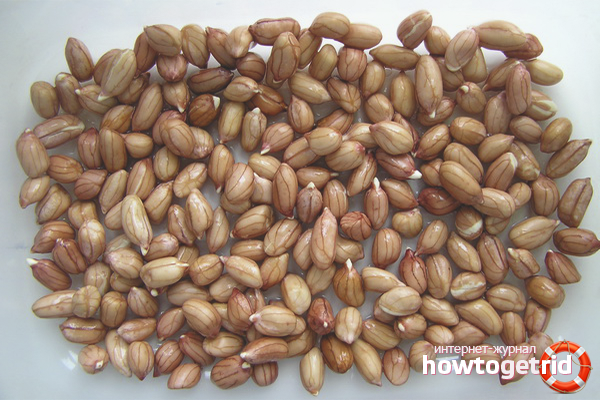
In order to awaken the vitality in the nuts, they are soaked in warm water for 4 hours. You can even add any biostimulant or adaptogen to the liquid:
- epin
- zircon
- aloe juice
The amount of the drug can be found on the package. Just do not exceed the dosage. The seeds will still take as much as they need. So why spend extra?
After soaking, the remaining liquid is drained, but you do not need to rinse the peanuts themselves. The beans should now be laid out in a single layer on a damp cotton cloth or paper towel. To do this, take a pallet or a wide flat plate (dish). Cover the soaked peanuts on top with another layer of cloth or loose paper. Then the entire structure is slightly moistened and placed in a warm place. Darkness is optional.
After about 23-25 hours, the halves of the beans should open slightly, and a small sprout will appear from the inside. Those seeds that have not woken up within 3 days are hardly viable. They can be safely thrown away or fed to livestock (poultry). Just before that, rinse them to remove the biostimulant from the surface.
After opening the beans, they can be planted in the garden almost immediately.
Advice. Soak peanuts at least 2 days prior to planting to ensure that beans are not viable.
how to grow cauliflower
Planting peanuts in the garden
Some people recommend planting the beans in holes. It is inconvenient and time consuming. Do you plant beans in furrows? And the peas too. And why are peanuts worse? Draw the grooves already, simplify the task for yourself. Leave the distance between them at least 30 cm. So later it will be easier to spud the plantings.
Sprinkle the grooves well with clean water. After all, at first, the sprouts need moisture. And by the time of planting, it is practically no longer in the ground. By the way, peanuts are planted in open ground around mid-late May. By this time, there is no longer a threat of recurrent frosts. And their peanuts can't stand it.
After watering, carefully lay out the soaked beans at a distance of 16-17 cm from each other. Then sprinkle with a layer of earth 6.5-8 cm. We do not mulch the beds. Now it remains to wait for the shoots.
Advice. If for 18 days the seedlings did not appear, then it means that you did something wrong.
how to grow melons outdoors
Peanut care
It is not at all difficult to care for seedlings. Periodic loosening of the soil, regular weeding and medium watering about once a week. We are waiting for flowering. It's hard to miss. Yellow-orange flower butterflies are clearly visible from afar.
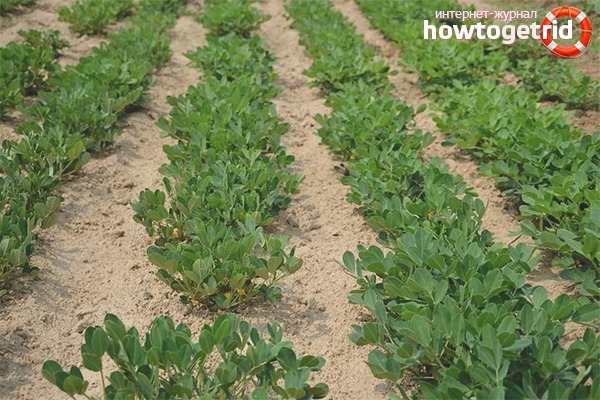
The peanut flower only lives for one day. In the morning it opens, by the evening it already withers. But there are a lot of them on the plant. It's funny to read that a peanut flower needs to be pollinated in these 12-15 hours. Some articles say so. This plant is completely self-pollinated and does well without outside help.
For the flowering period, care is a little more complicated. But don't let that scare you. The only difficulty is that you will have to water the peanuts more often. Approximately every 3-4 days. And feed it once with any phosphorus-potassium fertilizer.
Now it's time for hilling. Indeed, after flowering, the ovary sinks to the soil and buries itself in it. It is there that the formation of nuts occurs. Therefore, we need to help the plant a little. All hilling is reduced to three stages:
- With the onset of flowering, mounds are scooped up around the stems about 5 cm in height.
- After a week, the mounds are increased to a height of 13-14 cm.
- After the end of flowering, the last hilling is carried out. The height of the mounds is 22-25 cm.
This procedure allows you to get an earlier harvest. At the same time, it increases by almost 30%. After flowering, watering is again reduced to 1 time in 7-9 days. By mid-August, watering is gradually reduced, and by the end of August, it is reduced to nothing. Now all that remains is to wait for the harvest. True, during a cold snap below + 20 ° C (this sometimes happens), it is recommended to cover the landings with a film or dense non-woven material. Still, peanuts love warmth.
how to grow tobacco for smoking in the garden
Harvesting peanuts in the garden
The signal for the time of harvesting is the massive yellowing of leaves and shoots. Take your time to pull out the bushes with your hands. This will leave most of the crop in the soil. Use the most common garden forks. Just pry the bush, it comes out of the soil easily.
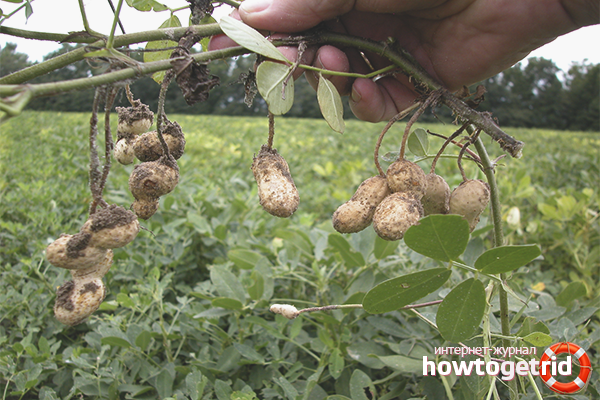
Of course, the temptation is now to peel the peanuts in order to dry them as soon as possible. But there is still a large amount of nutrients in the stems and shoots. Therefore, without breaking off the nuts, we carefully shake off the bushes from the ground. Then we hang them down with stems in a warm, dry room. It could be a barn or an attic. And only after the tops are completely dry, you can pick off the beans. During this time, all useful trace elements will be transferred to them from the stems.
Well, now you have your own peanuts. You can leave some for seeds for the next year, and the rest can be safely eaten.
Some helpful tips
- In our country, there are no diseases or pests that love peanuts. The only thing is that rot on the shoots can appear in a cool, humid summer.Therefore, if it rains, it is advisable to cover the plantings with a transparent film. Peanuts do not like excessive waterlogging of the soil.
- Do not plant multiple seeds in one hole. The peanut bush is always lush and spreading. He needs a certain amount of room to grow. And if all three seeds sprout, then instead of good development and proper growth there will be only a constant struggle for a place in the sun and food. In this case, the harvest will be meager, with small, tasteless beans.
- Usually peanuts are fully ripe by the end of September. But, it is better to dig out the bushes a little earlier, if in your area there are first frosts at this time. The fact is that the nuts begin to taste very bitter after frost. And bitterness is almost impossible to get rid of.
How to grow peanuts in the garden? It turns out to be very simple. Follow all the recommendations and you will be able to feast on nuts of your own production. And no exotic! Having tried to grow it once, you will prescribe this wonderful plant in your beds for a long time.
how to grow a good harvest of potatoes
Video: how to plant peanuts (groundnuts)
Many adults and kids alike enjoy eating delicious and nutritious peanut kernels. It is eaten on its own and complements some dishes. Its cores are distinguished by high nutritional value and benefits for the body. Peanuts quickly cause a feeling of fullness, which is why they are popular with those who are determined to control their own weight. Peanut kernels are rich in carbohydrates, proteins and fats. Peanut butter contains linolenic acid, vitamin B and vitamin E. Peanut butter contains folic acid.
Peanuts are an annual plant belonging to the legume family. The peanut bean is provided with a waist and a durable shell. There are fruits inside the bean. In peanuts, they are called kernels. Today, peanuts are no longer considered an exotic plant. Many amateur gardeners already know and share the secrets of how to grow peanuts at home.
Necessary conditions for growing
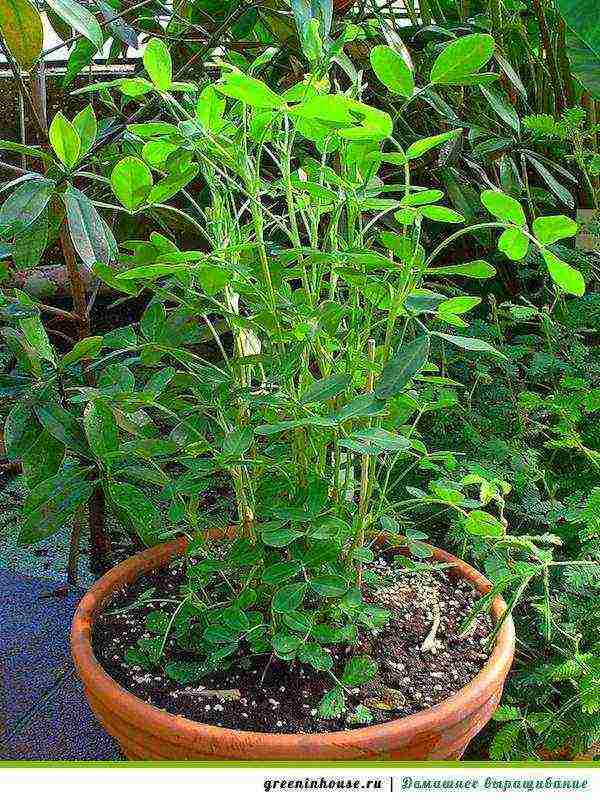
Lighting
An important condition for a rich harvest of peanuts in the garden is a sufficiently good level of lighting. The peanut bush should not be shaded by other plants.
If the cultivation of peanuts takes place at home, then you need to set aside a place for it with good lighting so that a sufficient amount of sunlight falls on the plant.
Window sills located on the east and south sides are perfect for this. If there is still little light, then you can use artificial lighting.
to the content ↑ Optimal temperature conditions
Temperature conditions play an important role in the cultivation of peanuts. A comfortable temperature for the plant is from 20 to 27 degrees. At temperatures exceeding + 30 degrees and falling below -15 degrees, the growth of a peanut bush stops.
Humidity level
During the flowering of peanuts, beans are formed underground, which constantly need moisture. In no case should water stagnation be allowed. Too high humidity slows down the maturation of the seeds. This is why peanuts should not be sprayed.
Tanks for growing peanuts
 Sprouted peanut seeds are transplanted from small cups into wide containers, since its shoots should not be allowed to hang down along the edge of the dish.
Sprouted peanut seeds are transplanted from small cups into wide containers, since its shoots should not be allowed to hang down along the edge of the dish.
As soon as the flowering period ends, fruits begin to form. Branches with ovaries begin to descend and burrow into the ground, where the fruits ripen.
In this regard, peanuts can only be planted in a sufficiently wide container.
to the content ↑ Selection of soil and its fertilization

Considering the fact that the fruits are formed in the ground, you need to carefully approach the choice of soil. Loose black soil is perfect for this, you can also plant seeds in sandy loam or neutral soil.
To grow a peanut plant, you need potassium, magnesium and a lot of humus.
to the content ↑ Fertilizers for fertilizing the soil
Growing peanuts requires repeated fertilization of the soil per season. Fertilizing with mineral fertilizers is done per one hundred square meters:
- Nitrogen is introduced in the amount of 0.45 - 0.6 kilograms;
- Phosphorus - the amount varies in the range of 0.5 - 0.6 kilograms;
- Potassium is applied exclusively to sandy loam soil in an amount not exceeding 0.45 kilograms.
Top dressing periods
Top dressing of the soil is carried out three times during the period of growing peanuts in the garden:
- The period of formation of these leaves.
- The period of tying buds.
- Fruit formation period.
Plant formation Seed selection
For planting, you can use grains that were harvested no earlier than 3 years ago.
The most popular varieties are currently:
- Runner;
- Virginia;
- Spanish;
- Valencia.
The following varieties are perfect for a temperate climate:
- Krasnodarets 13 and 14;
- Steplyak;
- Valencia 433;
- Klinskaya.
Before buying, you need to make sure that the seeds are not processed or roasted with anything.
back to contents ↑ Formation of bushes
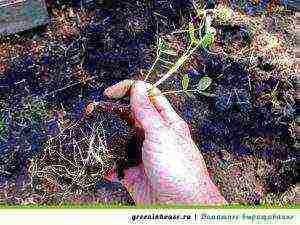
From the seeds of peanuts, a low bush is formed, which is a branched stem with feathery leaves of a dark green color and small yellow flowers.
Peanuts have one amazing feature: their flowering period is one day. This means that within 24 hours the flowers of the plant must have time to pollinate in order to ensure the formation of fruits.
back to content ↑ Protection against pests
The most common pests include a bear. To destroy it, you can make a bait. To do this, you need to collect cleaning and grain, then dig them in the garden next to the peanuts and cover with roofing felt. A little manure or humus is poured onto the top. From time to time, the bait needs to be checked and collected.
From seedling to first harvest
Growing peanuts begins with germinating the seeds. To do this, you can use a saucer on which the grains are soaked in a damp cloth.
In the first summer days, the sprouts are transplanted into the prepared soil in the garden. It is advisable to make the beds 45 centimeters wide, everyone chooses the length himself. The sprouts are planted at a distance of 15 centimeters from each other and 60 centimeters from another row.
In early April, the seeds should be planted in plastic cups. The planting depth should be about 3 centimeters. The cups are placed in a sunny place and watered.
back to content ↑ Care of peanut seedlings
In order to harvest a rich harvest, peanut bushes must be spilled several times per season:
- before flowering, you need to spud the plants, the height should be at least 50 centimeters;
- 10 days after flowering;
- then hilling should be done once every 10 days. Hilling should be stopped at the beginning of August.
Several times a season it is required to fertilize with mineral fertilizers.
back to content ↑ Harvesting
When the peanut bushes stop growing, their leaves and stems dry and turn yellow, you can start harvesting.
Plants need to be dug up and, shaking off the remnants of the earth, removed to dry. They should be dried along with the bushes. After about 10 days, the beans can be detached.
It turns out that growing peanuts at home and in the garden is a very simple process and every gardener can do it.
Similar articles:
